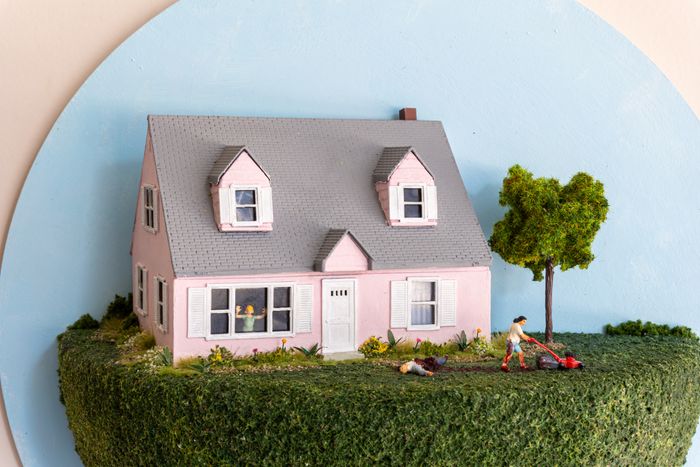
Abigail Goldman’s micro-renderings of scenes of carnage, created at 1:87 scale, are a testament to the pull of the small, especially at a time when art is getting bigger and more elaborately produced. In one tableau that could have come out of Breaking Bad, a shipping storage container in a gravel field contains a bloody corpse and a woman with her hands up as two gunmen nearby take aim. Another features a powder-blue van in a desert and two men warming their hands over an oil-drum fire, a mutilated corpse splayed between them. A third features a machine-gun-toting Queen Elizabeth and her two corgis standing over a dead man. Behind her, the paintings, the china in the cabinet, the upholstered chairs, the patterned wallpaper — all are perfect.
Goldman calls her works “Die-o-ramas.” I call them a cross between nightmares, documentary, and horror. In her day job, she is an investigator for a public defender outside Seattle, researching horrendous incidents of death, murder, and suicide. She started making the Die-o-ramas in 2012. One day, her husband posted images of her work on social media, where it attracted 15,000 comments. While she’s not well known in the art world, her work is now widely collected (one of her Die-o-rama snow globes is priced at only $700), and she’s been featured in the New York Times and even a short documentary about her practice.
Her new show, “State of Nature,” at the Hashimoto Contemporary gallery, is reminiscent of science-fair displays and natural-history exhibitions. I love miniature, mad-scientist worlds like these and follow scores of Instagram accounts devoted to teeny record albums, dolls, and cars, and tiny foods being prepared in tiny kitchens with tiny tools. All this exists at a remove from the art world. When I told a close friend I was reviewing Goldman’s show, she said, “Why?”
But, of course, there is a long lineage of artists working in wee spaces. Lori Nix creates mad slum scenes, destroyed libraries, and postapocalyptic living rooms. Joe Fig has done small replicas of the studios of Jackson Pollock, April Gornik, Chuck Close, and other artists. Janet Cardiff has included models of haunted houses in her elaborate exhibitions. A masterpiece of the genre is Hell, by Jake and Dinos Chapman, a series of containers configured in the shape of a swastika depicting thousands of Nazis being impaled, tortured, and torn apart by tiny demons.
Goldman’s grotesque scenes are often set in subtle locations. The window of a suburban home reveals a naked woman in a chair and, in the darkness beyond her, a dead man on the floor. One Die-o-rama features a man taking a picture of a woman posing topless in disheveled woods. I’m skeptical when things get really bloody. These pieces spill over into farce, melodrama, parody. A restaurant shows a batch of happy diners while in the kitchen, someone is cutting up a dead body. It’s like the movie The Menu. There are decapitations, buried bodies, pools of blood everywhere. I also don’t love the way the viewer is held at a distance by plexiglass encasements.
But the best of her ghoulish work has the feeling of films like Fargo or The Florida Project, a nether zone where everything is intricately suspended in its own atmosphere and restrained to the point that it comes across as fiction in the guise of documentary. These are works that make us feel a true American horror story.

